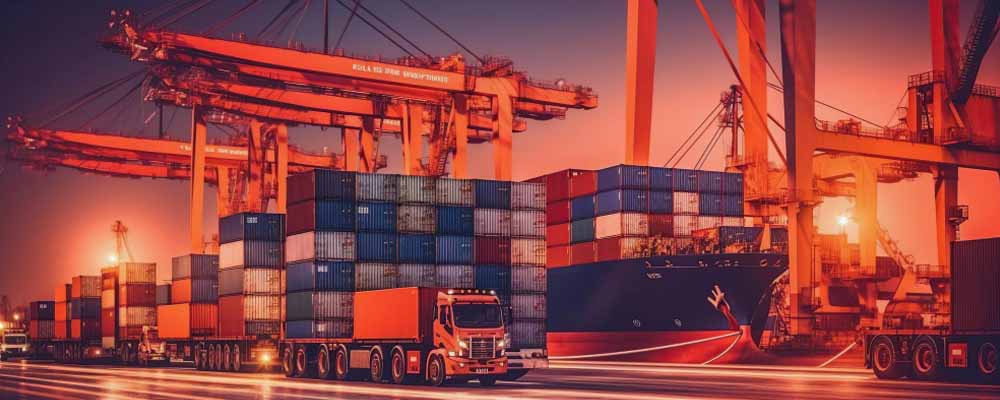 India is a promising country for international trade. As one of the most populous countries in the world, India’s market presents substantial potential for businesses and entrepreneurs supplying consumer goods, electronics, and other key import products.
India is a promising country for international trade. As one of the most populous countries in the world, India’s market presents substantial potential for businesses and entrepreneurs supplying consumer goods, electronics, and other key import products.
If you’re exploring shipping options and logistics in line with importing to India, this blog post might be of help to you. Read on for insights regarding Indian ports, typical transit time, average costs and paperwork required for shipping.
 What are the Ways to ship to India?
What are the Ways to ship to India?
When considering the mode of transportation to avail for shipment to India, the type and quantity of goods, finance issues, time constraints and other factors must be accounted for. Here are some options to choose from:
- Ocean freight– It is a common method of transporting goods due to its affordability and flexibility, best for non-perishable and sizeable amounts of goods.
- Air freight – Characterized by rapid delivery but at a more expensive cost. It is usually the preferred way to ship valuable and high-priority goods.
- Land Transportation – Road or rail transport can be utilized for this option. It is ideal for trucking goods from India’s neighboring countries. It is also used to move products from ports to the end destinations.
- Courier Service– For low quantity small to medium packages and documents, availing courier service may be the best pick. They offer door-to-door delivery as well as tracking and insurance options.
- Multimodal Transport– It comprises two or more modes of goods transport for end-to-end shipping solutions.
What are the Main Ports in India?
As a gateway to India’s centers of trade, the major ports discussed below serve as a connection between India and the global marketplace. They form an important part of India’s maritime infrastructure that contributes to the overall development of the country.
Jawaharlal Nehru Port Trust in Maharashtra is the largest container port the country and can accommodate a huge fraction of India’s containerized cargo. Ranking as the second largest port, Chennai Port Trust is situated in Tamil Nadu second-largest port in India manages many types of cargo such as containers, bulk cargo, and petroleum products. Meanwhile, Visakhapatnam Port Trust in Andhra Pradesh is a main entry point for trade on the east coast of India, specifically for iron ore.
| Port | Average Annual TEU’s |
| Jawaharlal Nehru Port | 5,835,650 TEUs |
| Mumbai Port | 4,400,000 TEU |
| Chennai Port | 1,602,319 TEU’s |
| Visakhapatnam Port | 512,000 TEU |
| Paradip Port | 6,49,730 Metric Tonnes |
| Kolkata Port | 6,75,904 TEU |
| Mormugao Port | |
| Kochi Port | 735,577 TEU |
How much does it cost to ship a container to India?
Numerous elements can affect the total cost of shipping a container to India. Container size and type matter with bigger and more specialized containers costing more. For the container condition, new and one-way containers are more expensive than used ones. The distance between the starting and end point of delivery must also be considered. Location in relation to the supply and demand in a geographic location differs- higher demands for container ships in festive seasons may result to more expensive shipping.
Here’s a rough estimate of shipping costs to India:
| Country | 20ft | 40ft |
| United States | $1,500 to $4,000 | $2,500 to $6,000 |
| European countries | $1,200 to $3,500 | $2,000 to $5,500 |
| China | $800 to $2,500 | $1,500 to $4,500 |
| Other Asian countries | $700 to $2,000 | $1,200 to $3,500 |
What is the Transit Time when shipping to India?
The expected transit time when shipping to India is 20 to 54 days, depending on the country where the goods came from. Primary factors influencing the transit times are the route and distance between the origin port and the destination port. The secondary considerations are unpredicted incidents while in transport such as weather conditions and port schedule delays.
Average days when shipping to India:
| Country | Days |
| United States | 25 to 45 days |
| European countries | 20 to 35 days |
| China | 15 to 30 days |
| Other Asian countries | 10 to 25 days |
What paperwork is needed for international shipments to India?
Proper documentation is required for a successful importation to India. Here’s a list of paperwork needed for customs clearance following import regulations:
- Commercial Invoice
- Packing List
- Certificate of Origin
- Bill of Lading/ Air Waybill
- Customs Declaration Forms
- Importer Code/ Exporter Code
- Additional Documentation for certain goods
To facilitate a smoother international importation, India has gradually made the process easier over the last decade. The majority of goods are categorized under India’s Open General License which equates to freely importable goods without restrictions and a license except for regulated items as stated by the law.
Imports that are not covered by the Open General License are controlled and characterized under three subtypes:
- banned items
- restricted items- require an import license .
- “canalized” items- only government trading monopolies have the power to import these goods and the quantity and timing depend on the approval of the Cabinet.
 How do I find a freight forwarder in India
How do I find a freight forwarder in India
Assistance from customs brokers, freight forwarders and shipping companies significantly impacts the accomplishment of a timely and effective importation to India. If you are seeking the right freight forwarder to help you with this venture, Pangea has your back. Finding the best solutions for your individual importation needs is Pangea’s expertise. For more information, please feel free to visit https://pangea-network.com/.
Frequently Asked Questions
- What is the estimated transit time for shipping a container to India?
The expected transit time when shipping to India is 20 to 54 days, depending on the country where the goods came from. Primary factors influencing the transit times are the route and distance between the origin port and the destination port. The secondary considerations are unpredicted incidents while in transport such as weather conditions and port schedule delays.
- How do you figure out the shipping cost to India?
Numerous elements can affect the total cost of shipping a container to India: Container size and type, container condition, distance between the starting and end point of delivery, and location in relation to the supply and demand in a geographic location among others. See rough estimates above.
 Conclusion
Conclusion
The rapidly evolving market of India holds lots of possibilities for businesses around the world. Optimizing the supply chain operations in the country can prove profitable, especially for in-demand industries. Backed up by an extensive network of freight forwarders in India, Pangea can offer you a hassle-free importation service. Having a trusted partner such as Pangea can make your import journey a hundred-fold easier.
 How do I find a freight forwarder in India
How do I find a freight forwarder in India Conclusion
Conclusion